- Home
- Physics– PHY
Physics– PHY
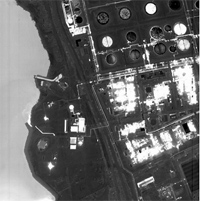 The Physics scientific domain is tasked with designing and producing measurement and observation resources for aerospace applications, both defense and civil. Its activity covers the entire range from fundamental components up to systems integrated in their environment. These resources need to meet the challenges presented by observation, detection, identification and measurement that are as non-intrusive as possible, at ever-longer distances, more rapidly, and with continually-enhanced resolution and experimental robustness, in order to better understand the physics at work in the observed phenomena.
The Physics scientific domain is tasked with designing and producing measurement and observation resources for aerospace applications, both defense and civil. Its activity covers the entire range from fundamental components up to systems integrated in their environment. These resources need to meet the challenges presented by observation, detection, identification and measurement that are as non-intrusive as possible, at ever-longer distances, more rapidly, and with continually-enhanced resolution and experimental robustness, in order to better understand the physics at work in the observed phenomena.
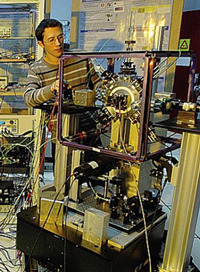 The researchers in the Physics domain work in the Optics and associated techniques department (DOTA), the Electromagnetism and radar department (DEMR) and the Physics, instrumentation and space department (DPHY). Through their activity, these researchers contribute in this way to the most recent scientific progress in the fields of high potential technologies (nanotechnologies, micro- and nano-electronics, photonics), signal and data processing, and quantum technologies (photodetectors, coherent sources, cold atom systems, etc.).
The researchers in the Physics domain work in the Optics and associated techniques department (DOTA), the Electromagnetism and radar department (DEMR) and the Physics, instrumentation and space department (DPHY). Through their activity, these researchers contribute in this way to the most recent scientific progress in the fields of high potential technologies (nanotechnologies, micro- and nano-electronics, photonics), signal and data processing, and quantum technologies (photodetectors, coherent sources, cold atom systems, etc.).
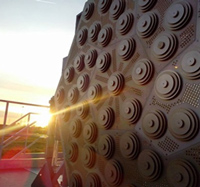
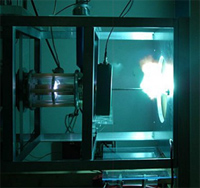
We support strategic developments by laying the groundwork for new market opportunities (safety, environment), anticipating electromagnetic and optronics warfare, and exploring the potential offered by the increasing use of drones and nanosatellites.
Scientific topics of the Physics domain
The PHY domain covers 22 scientific topics spread across 3 departments of ONERA.
| Topics | Scientific Department | References (CNU - CoNRS) |
| Electromagnetic compatibility | DEMR | 63 - 8, 6 |
| Radar imaging and remote detection | DEMR | 63 - 8, 6 |
| Propagation and radio communications | DEMR | 63 - 8, 6 |
| Systems and technologies for radar and electronic warfare | DEMR | 63 - 8 |
| Signal processing for radar and electronic warfare | DEMR | 63 - 8, 6 |
| Antennas, microwave materials and stealth technology | DEMR | 63 - 8, 3 |
| Simulation of the electromagnetic scene | DEMR | 63 - 8 |
| High-performance space accelerometry | DPHY | 63, 28 - 3 |
| Cold-atom inertial sensors | DPHY | 63 - 4 |
| Electrostatic charges and discharges on satellites | DPHY | 63, 28 - 3 |
| Effects of the radiative aerospace environment on onboard systems | DPHY | 63, 28 - 3 |
| Interaction of the space environment with materials | DPHY | 63, 28 - 3 |
| Lightning, plasma and electric thrusters | DPHY | 63 - 4 |
| Instrumentation and metrology via laser spectroscopy | DPHY | 30, 63 - 4, 8 |
| Micro/nano-systems (MEMS/NEMS) and miniature inertial sensors | DPHY | 63 - 3 |
| Space environment models and measurements | DPHY | 63, 28 - 19, 3 |
| Active and passive remote detection | DOTA | 63 - 4 |
| Wave surface control, adaptive optics | DOTA | 30 - 4, 5 |
| Optoelectronics: photo detection and nanophotonics | DOTA | 63 - 3, 4, 8 |
| Fiber lasers, lidars and 3D imagers | DOTA | 30, 63 - 4 |
| Optical sensors and hyperspectral imagers | DOTA | 30 - 4 |
| Environment and signatures for optronic sensors | DOTA | 30 - 4, 5 |
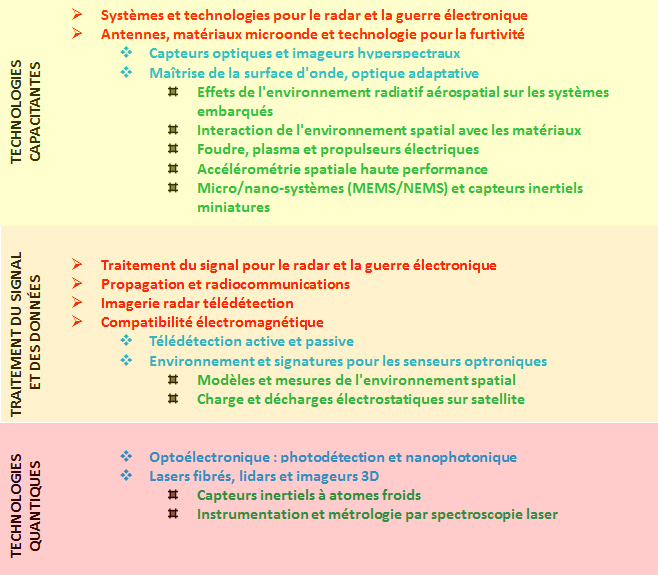
ElectroMagnetism and Radar (DEMR)
Optics and Associated Techniques (DOTA)
Physis Instrumentation Environment Space (DPHY)